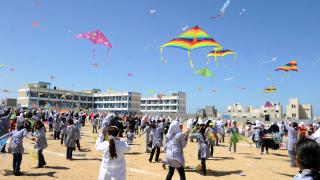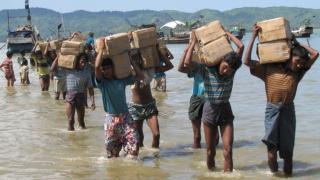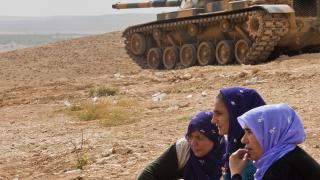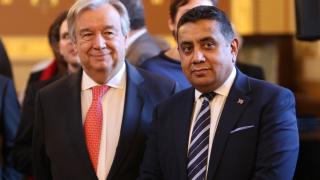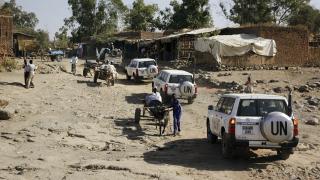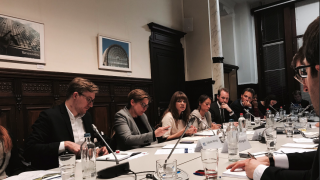
Introduction: The objectives, development and implementation of R2P
Presentation given at a workshop on R2P in the Middle East and North Africa, organised by the UN Office for the Prevention of Genocide and R2P, the International Coalition for R2P and the Permanent Peace Movement, 18 December 2014, Amman, Jordan.
Asalaam alaykum. Hello, my name is Alexandra Buskie and I am the peace and security programmes officer at the United Nations Association - UK. We are a small charity based in the United Kingdom that provides information and analysis about the work of the UN. One of our core aims is to make the UN more understandable and bring it closer to people. I'm here to talk to you today about a principle called the Responsibility to Protect, or R2P, as defined and practiced by the UN and its member states.
Learning about R2P can be daunting if you are unfamiliar with UN language; the development of the principle is almost unavoidably full of jargon and technical UN terms. The language of R2P has also developed over time.
In this presentation, I am going to try and strip this down as much as possible and try to clarify what exactly R2P is, what is important for you to know about its development and how it is being put into practice today.
As with learning any language, it's always best to start with the basics. So, I'm going to start by expanding on what R2P is at its core, before adding more layers to your knowledge about where it came from and where it is going.
Basics
The Responsibility to Protect is an emerging norm and a political principle for preventing and responding to four distinct crimes: genocide, war crimes, crimes against humanity and ethnic cleansing. These are often collectively referred to as atrocity crimes or R2P crimes.
What does that mean? Well let's start by ruling out what it is not. R2P is not a law, nor a legally binding framework. The crimes that it seeks to prevent are defined in international law, such as the Genocide Convention, the Geneva Conventions and additional protocols and the Rome Statute of the International Criminal Court, but R2P itself is not a legal framework. I believe we are going to hear about its legal basis later today.
So, if we already have law defining these crimes and the need to prevent and punish perpetrators, why do we need R2P?
Let's go back to what R2P is - an emerging international norm. It is a norm that seeks to facilitate the implementation of these agreed laws. The core principle of this is that all states have a responsibility to protect their populations from R2P crimes. It establishes that the protection of people from these crimes lies first with the state.
However, as we all know, not all states are able or willing to uphold this responsibility all of the time; they sometimes need help, encouragement or even more forceful interventions. And so R2P assigns additional responsibilities to the international community - meaning all member states of the UN - as well as to international and regional organisations and non-governmental organisations.
R2P holds that this international community has a responsibility to assist other countries in upholding their responsibility and should states be unwilling or unable to protect, the international community should respond and take action to protect. This may be by using diplomatic, humanitarian and other peaceful means like human rights monitors, for example, to protect populations. Stronger measures, like enforced sanctions or the use of military force authorised by the UN Security Council, can also be used if states are clearly failing to protect. You can see that the international community has many different tools at its disposal for upholding its responsibility.
So, you have three layers - or 'pillars' - of responsibility: that of the state, that of the international community to assist and that of the international community to take decisive action should a state fail to protect.
This still doesn't really answer the question of why we need R2P. We have the law, why do we need this norm? The answer to this can be seen in the realities and challenges faced by states when they are confronted by the commission of atrocity crimes.
It is not new to say that the end of the 20th century and the beginning of the 21st have been marked by an increase in internal conflicts rather than wars between states, making civilians the main casualty of war.
The Holocaust, genocides in Cambodia and Rwanda and crimes against humanity in the former Yugoslavia, East Timor, Sri Lanka, Darfur and Syria demonstrate extreme failures by the international community to respond to the threat of atrocity crimes. Contemporary crises have challenged world leaders with complex choices regarding when and how they should act to protect populations abroad and live up to the conventions and laws to which they are signatories. R2P seeks to clarify where responsibility lies and to provide guidance on what sort of action should be taken to prevent these crimes from taking place or from escalating.
Development 1: Getting to 2005
So where did the idea for the principle of R2P come from?
There was a growing recognition in these 1990s that the world needed to be better equipped to deal with the complex crises and extreme abuses of human rights emanating from within states rather than between them. The failure to protect populations in Rwanda has a particularly strong legacy in the development of R2P, as does the military intervention in Kosovo in 1999 which was argued to be a humanitarian intervention to protect populations from atrocity crimes, but was criticised by some states as being an assault on state sovereignty.
State leaders, academics and practitioners realised they needed a way of reconciling two seemingly conflicting international norms.
Firstly, the belief in the central importance of state sovereignty and non-intervention in domestic affairs. This is a norm that is enshrined in international law through the United Nations Charter and forms the basis of international relations today.
Secondly, the recognition that we need to protect human rights and invest in human security, as opposed to just state security. This recognition is both moral - in that we cannot just watch horrors unfold upon other humans - and based on an understanding of international security that identifies mass atrocities and the displacement, suffering and impunity that often accompanies them as threats to stability and security far beyond the borders of the conflict.
The then Secretary-General of the UN, Kofi Annan, played a key role in challenging governments to address this tension. In 1999 he asked governments "if humanitarian intervention is indeed an unacceptable assault on sovereignty, how should we respond to a Rwanda, to a Srebrenica - to gross violations of human rights that affect every precept of our common humanity?"
R2P has become the world's answer to this question.
As a principle, R2P aims to reconcile the two sides. It stresses that state sovereignty includes both rights and responsibilities: a right to govern over a territory, but a responsibility to the population living in that territory.
The term Responsibility to Protect comes from a report written in response to Kofi Annan's call. Published in 2001, the report was written by an independent group of experts - called the International Commission on Intervention and State Sovereignty. Their main aim in this report was to reconcile state sovereignty and intervention for the protection of human rights.
I am not going to go into the details of this report since we don't have much time and I want to get onto the version of R2P that has been agreed by UN member states. However, I do want to highlight three main ideas that came from this report;
- Firstly, the name Responsibility to Protect - it is important to remember that there have been different iterations of R2P and that we shouldn't mix them up. This 2001 document is not the same as the R2P that was agreed by member states later in 2005.
- Secondly, this report outlined and expanded on the idea of sovereignty as responsibility. It argued that if a state wants to be considered as sovereign, it must acknowledge its internal responsibilities to its populations. In essence, it suggested that the right to non-intervention should be conditional on the ability and willingness of the state to protect human rights.
- Thirdly, it argued that if a state is unwilling or unable to uphold its responsibilities to its populations, then the international community has the responsibility to step in to prevent or respond to atrocities - and they focused heavily on military intervention as a response- and to rebuild afterwards.
So if that was an independent report written in 2001, how did R2P get to the UN and become a endorsed by member states?
Th UN Secretary-General, Kofi Annan, was keen to strengthen the UN during his term and improve its ability to make progress on development, security and human rights. He formed an independent panel of international experts to see how to improve the UN and make sure it would be able to deal with the challenges of the 21st century, like the increasing number of internal conflicts. This group produced a report in 2004 that recommended that the UN endorsed the idea that states had a responsibility to protect their populations from grave threats to human rights.
Kofi Annan then published his own report in 2004 - an official UN report - which he based on the recommendations of that expert group. He also called on governments to adopt the idea of R2P and its recognition that governments have a primary responsibility to protect their populations and that the international community also had the responsibility to step in when a state is unable or unwilling. He also suggested that there was a range of different policies states could undertake to stand up to this responsibility, not just military. States should use all the tools at the UN's disposal.
So by the time we get to 2005, R2P has gone from an idea that sovereignty entails responsibility, to an international report outlining this responsibility, to an endorsement by the UN Secretary-General and a recommendation to all states to agree on this idea.
Development 2: The 2005 World Summit Outcome document
2005 marked 60 years since the establishment of the UN and member states came together to renew their commitment to the organisation and agree on reforms to update it and make it fit for the challenges of today. This World Summit saw the largest gathering of state and government leaders, who all agreed that R2P should be part of the document summing up the conclusions of their meeting. R2P was unanimously endorsed by all UN member states in paragraphs 138 and 139 of the summit outcome document. It is important to note that it was southern governments - like Argentina, Chile, Mexico, Rwanda and South Africa - who played key leadership roles in persuading others to adopt a meaningful commitment to R2P.
I think we have a slide with the translation of these paragraphs for you: 138-139.
So you can see the agreement that states came to; they endorsed the idea that it is the responsibity of each individual state to protect its populations from four crimes: genocide, war crimes, crimes against humanity and ethnic cleansing.
You can also see that they agreed that the international community has a responsibility to encourage and help states to exercise this responsibility.
The second paragraph focuses on the responsibilities if the international community where states are clearly failing to protect their populations. You can see that a wide range of tools and policies are mentioned, such as diplomatic, humanitarian and other peaceful measures; references to chapters six and eight of the UN Charter which are about peaceful means for settling disputes; and the support of regional organisations. It also says that states can take action in accordance with chapter seven of the Charter, which is about the use of force, so long as it is authorised by the Security Council and decided on a case-by-case basis.
The final paragraph 140 endorses and supports the mission of the UN office for genocide prevention.
If we break this down from its technical UN terms, what does it mean?
- States have agreed that they all have a responsibility to protect their populations from the four atrocity crimes
- They have all agreed that they have a responsibility as members of the international community to assist other states and help to build capacity
- States have agreed to respond to threats of atrocity crimes with a wider range of measures, from diplomacy to sanctions and use of force;
- They have agreed to use coercive measures, such as the use of force, only with the authorisation of the Security Council and only on a case-by-case basis
- They have also agreed that they should continue to consider this agreement and its implications in the General Assembly, meaning that they have agreed to continue to talk about it and refine it
This is the most important iteration of R2P today. Any earlier versions (any of the earlier reports) are important for the development of the concept and important for how we got here, but are not what was finally agreed by all member states.
Development 3: 2005 to today
Since this endorsement at the 2005 World Summit, there has been a number of important normative developments at the United Nations.
Firstly, Secretary-General Ban Ki-moon created two positions to work on genocide prevention and R2P in a joint office: a special adviser on genocide prevention, currently Mr Adama Dieng, and another special adviser on R2P, currently Dr Jennifer Welsh. We have a representative from the joint office who will speak more about their work later.
Secondly, since 2009, the Secretary-General has written an annual report focusing on a different aspect of putting R2P into practice. So far he has published six reports:
- Implementing R2P: this report officially split R2P into those three layers of responsibility I have been talking about - the primary responsibility of the state, the responsibility of the international community to assist and the responsibility of the international community to take timely and decisive action to respond to threats of atrocity. This report called these layers 'pillars', so we talk about the three pillars of R2P.
- Early warning and assessment
- The role of regional and subregional organisations in putting R2P into practice
- How to put the third pillar on timely and decisive response into practice
- How to put the first pillar on the states' internal responsibility into practice
- How to put the second pillar on the international community's responsibility to assist into practice
These all add to the advancement of this principle, and to the understanding of how the principle works in practice.
Each year, after the publication of the Secretary-General's report, the General Assembly meets informally to discuss its contents, to share lessons learned and its concerns, and to encourage each other to continue implementing R2P and supporting others to meet their responsibities. The General Assembly also passed a resolution in 2009 supporting the continued consideration of the principle. These resolutions are not binding but demonstrate the continuing and widespread support for R2P amongst the 193 members of the General Assembly.
At the level of the Security Council, R2P has informed and been explicitly referenced in 26 resolutions since its first reference in 2006. The Security Council's resolutions are binding and can authorise things like sanctions, political missions, peacekeeping operations or even military force.
These resolutions are both thematic - on topics like the protection of civilians in armed conflict or the upholding of international peace and security - and on particular country cases. For example, Resolution 1706 referred to states' responsibility to protect when setting up a peacekeeping mission in Darfur. Another example is the reference made to R2P when the Security Council adopted Resolutions 1970 and 1973 on Libya. 1970 called on Libya to uphold its responsibilities to its populations and adopted measures like sanctions on the ruling elite while also referring Libyan Prime Minister Gaddafi to the International Criminal Court. When this did not deter the Government from attacking its population, a second resolution, 1973, approved a military no-fly zone over Libya, called for a ceasefire and tightened sanctions on the Government.
While this is probably the most well known Security Council action referring to R2P, there have been many other resolutions recalling states' responsibilities, for example, on Côte d'Ivoire, in Yemen, Sudan, Mali and others. What's more, the Security Council has not been put off R2P due to its experience in Libya, and it has mentioned R2P in more resolutions after it than before.
However, the Security Council is where action is usually taking place under pillar three - a timely and decisive response - rather than on the long term preventive side. It is important to remember that R2P does not belong to the Security Council and in order to prevent atrocity crimes, we should be acting long before an issue gets onto the Council's agenda.
The UN's human rights mechanisms are also becoming increasingly involved in supporting and upholding R2P. The Human Rights Council has held a side event considering R2P and human rights, and the Secretary-General has recently established an initiative seeking to place human rights at the centre of everything the UN does, called the Human Rights Up Front initiative, and is stressing that the upholding of human rights throughout the UN system is key for early prevention of atrocity crimes.
Conclusion
I've taken you on a bit of a whirlwind tour of the development of R2P. There will be time to talk in more detail during the discussion but I hope I have made a couple of key messages clear for you:
- R2P is a political principle and emerging international norm for the prevention of the four atrocity crimes.
- It has developed throughout the 1990s and early 2000s but the most important iteration of the principle was at the 2005 World Summit in those paragraphs we went through.
- The principle itself is made up of three layers or 'pillars' in UN-speak. The primary responsibility of the state, the responsibility of the international community to assist, the responsibility of the international community to respond.
- The principle is becoming normalised in the the UN system; it is present in the secretariat through the joint office; the General Assembly meets to speak about it every year; the Security Council uses it in resolutions; and it is beginning to progress in the UN's human rights mechanisms and agendas.
Thank you very much for listening and let me know if you have any questions in the discussion.

